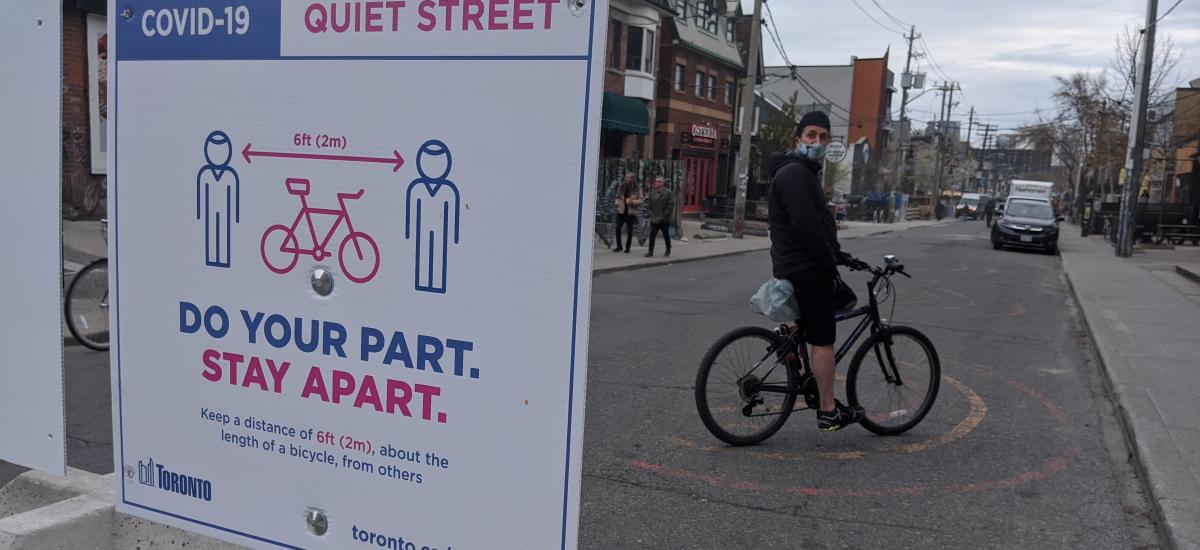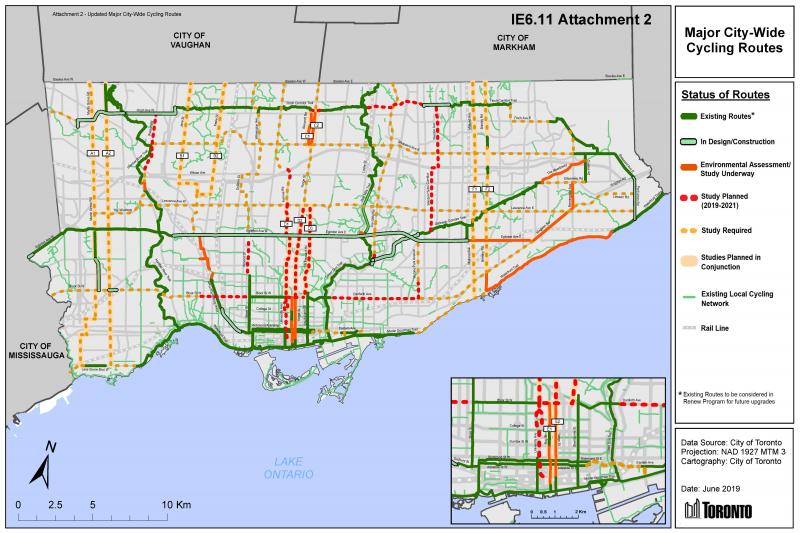First look at how ActiveTO will roll out

Cycle Toronto has been advocating for safe space for active transportation as part of the COVID-19 response and recovery for nearly two months. In our open letter to the Office of Recovery and Rebuild, Cycle Toronto proposed three general guidelines around which to focus an active transportation strategy in the short-term so as to build Toronto’s resiliency in the long-term:
- Support essential workers and trips to essential businesses.
- Enable sufficient access to outdoor space.
- Accelerate economic recovery and connect communities.
Many of the strategies we called for in our open letter and subsequent one-on-one discussions with City Councillors and City staff are focus points in ActiveTO, the city’s plan to rebalance streets and provide space for active transportation.
ActiveTO includes 3 components: ‘Quiet Streets’, temporary major road closures, and accelerating the Cycling Network Plan. ActiveTO was first announced on Wednesday May 6 and further details were announced on Thursday May 14 for implementation before the May holiday weekend.
What has been announced?
Click on the icon in the upper left corner to see the map legend.
1. Quiet Streets
Quiet Streets can form low-traffic, calm neighbourhoods to reduce through traffic while maintaining vehicle access for residents, by strategically creating culs-de-sac and allowing vehicle permeability on the arterial streets that border the neighbourhood. Quiet Streets blocked together into quiet neighbourhoods can massively expand the cycling network very quickly by creating many low-stress routes. Quiet neighbourhoods are created in many Dutch cities, with Barcelona's “superblocks,” and in liveable neighbourhoods in London, UK. Currently one third of all trips in Toronto are less than 5km. Quiet Streets can make more of those trips safe to bike. Many Torontonians are valuing how quiet their streets are during lockdown, and would like it to continue as the city begins to reopen.
Oakland Slow Streets. Photo: OakDOT
See the complete list of streets at bottom of this post.
2. Temporary Road Closures
This weekend, there will be three major road closures: one next to the Martin Goodman Waterfront Trail along Lakeshore Blvd W from Windermere Ave to Stadium Rd, and two adjacent to the Don Valley along Bayview Ave and River St between Mill St, Rosedale Valley Rd, and Gerrard St.
These temporary road closures can help alleviate the congestion and ability to maintain physical distance in parks and on trails on weekends and holidays by allowing people to spread onto the roadway. We know other parts of our trail network remain congested and we will continue to push for more closures next to other crowded trails.
3. Accelerate the Cycling Network Plan
Cycle Toronto is disappointed Thursday’s announcement did not include an update on Council's direction to accelerate the permanent cycling network plan, or creating a temporary network of bike lanes both identified as part of ActiveTO. The Mayor noted that while driving and walking are at “all-time lows,” cycling has maintained pre-COVID levels in many areas. As the city begins to reopen and the weather improves, bicycle infrastructure will be crucial as a TTC safety valve, helping offset the increased demand along transit lines including subway lines and busy bus routes.
Outside the downtown core, where there are fewer mobility options and crowded buses, the need for access to safe active transportation corridors is essential for people to maintain physical distancing. We need temporary bike lanes now so that permanent, protected lanes can be built as part of an equitable recovery.
We will continue to call for our major campaigns along Bloor, Danforth, Yonge, and Eglinton to be built as quickly as possible. We need the City to begin building the key citywide projects that are identified in the Cycling Network Plan so that the next set of projects can be advanced. Recent polling has shown that 79% of people from every corner of Toronto support building protected bicycle lanes, so we need to get building.
Major City Wide Cycling Routes. Source: City of Toronto
What comes next?
The interventions announced on Thursday begin to offer important community connectivity, support the ability to shop local and support local businesses, and create more space on crowded trails and parks to promote physical and mental health.
We need many more kilometres of quiet streets, and more street closures next to popular destinations as our response to the pandemic shifts and summer weather arrives. These streets can connect elements of the cycling network and park/ravine network. Torontonians have been vocal about how much value there is in quiet streets and would like it to continue.
While quiet streets and major road closures are a good start (and more will be needed), temporary and permanent bike lanes as part of an active transportation network need to be advanced ASAP to give Torontonians the room we need as we recover. As framed in ActiveTO, accelerating the Cycling Network Plan is essential. Our major campaigns are for protected bike lanes along Bloor, Danforth, Yonge, and Eglinton, and we are still calling for these projects to be installed as quickly as possible.
We need your help!
Let the City know where and what kind of future interventions you would like to see in your ward or across the city, please email active_to@toronto.ca, and include your councillor and Cycle Toronto at info@cycleto.ca.
We’re working with our ward advocacy groups to identify which parts of the Cycling Network Plan need to be accelerated and also identifying gaps in the Plan. The core of the city has a growing network of cycling lanes, but there are many parts of the city with little infrastructure. We’re thinking carefully, knowing there is a unique urgency about how we can bring cycling infrastructure to the entire city, not just the core, with a mind for equity.
It is our responsibility as a city to learn and change the way we do things in a post-COVID world. While Thursday's announcement is a step forward, more needs to be done and soon. We will continue to push for ActiveTO to be rolled out quickly, expanded rapidly, and made permanent. Toronto cannot revert to the status quo when the pandemic is over.
The way we advocate has transformed during COVID-19. We’ve moved quickly to adapt and transform our advocacy, but at the end of the day, we are still advocating for our members. As we’ve shifted our operations online, many of our usual fundraising activities have been cancelled. If you value the work we do, please join or make a donation. Even $5 a month supports our educational outreach, running (virtual) events and workshops, and ensures you have a strong voice at City Hall.
Learn about membership or Donate
Michael Longfield
Interim Executive Director
Ful llist of confirmed Quiet Street locations, as of May 14, from the City's ActiveTO webpage:
- Kensington Market (area that borders Nassau Ave., Spadina Ave, Augusta Ave. and Dundas St. W.)
- Shaughnessy Blvd. between Van Horne Ave. and Havenbrook Blvd.
- Havenbrook Blvd. between Shaughnessy and Manorpark Ct.
- Lakeshore Dr./Lake Promenade (First Ave. to Forty Second St.)
- High Park Ave. (Bloor St. W. to Annette St.)
- Brock/Emerson/Cowan Ave. (Dupont St. to King St. W.)
- Winona Dr. (Eglinton Ave. to Davenport Rd.)
- The Esplanade (boundaries TBC)
- Crawford St./Montrose Ave. (Bloor St. W. to Queen St. W.)
- Howard and Earl Streets (Sherbourne St. to Parliament St.)
- Sackville/Sumach Streets (Shuter St. to Gerrard St. E.)
- Monarch Park Ave. (Felstead Ave. to Sammon Ave.)
- Fulton/Sammon Avenues (Broadview Ave. to Monarch Park Ave.)
- Woodfield Rd. (Knox Ave. to Walpole Ave.)
- Lee Ave. (Kingston Rd. to Alfresco Lawn)
- Secord Ave./Eastdale Ave./Lumsden Ave./Main St./Hamstead Ave./West Lake Ave. (Dawes Rd. to Oak Park Ave.)
- Military Trail/Highcastle Rd. (Sealstone Terrace to Bonspiel Dr.)
- Kew Beach Ave. (Waverly Rd to Lake Shore Blvd. E.)
- Westview Blvd. (St Clair Ave. E. to Holland Ave.)
- Dundalk Dr. (Ellesmere Rd. to Antrim Cr.)
- Trudelle St./Cedar Brae Blvd. (Danforth Rd. to Bellamy Rd.)

